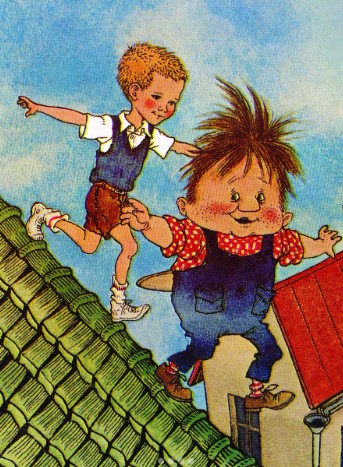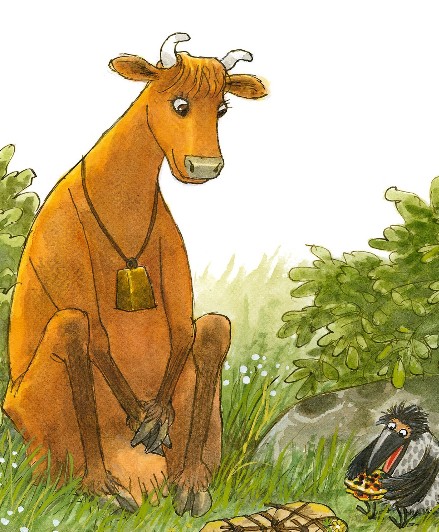Children in Sweden
Strong rights and school for all. Here are 10 aspects of children's lives in Sweden.
1. Schooling in Sweden
Ever since 1842, children in Sweden have had the right to go to school, by law. Today there are ten years of compulsory schooling, divided into four stages: förskoleklass (‘pre-school year’, year 0), lågstadiet (years 1–3), mellanstadiet (years 4–6) and högstadiet (years 7–9).
Most children then go on to the optional gymnasium (upper secondary school – the equivalent of Brithish sixth form or American high school, years 10–12) and graduate when they are 18 or 19 years old.
School is fully tax-subsidised, with the exception of nursery schools, which are partly funded by the government. Before and after school hours, children between 6 and 13 are offered out-of-school care at a subsidised cost.
Compulsory education also includes sameskolor (Sami schools) for children of the indigenous Sami people. Children with special needs get the opportunity to study in regular schools. If this is not suitable, there are also special schools.
The school year
The Swedish school year runs from August to June, with an autumn break in October, a Christmas holiday, a winter break in February–March and an Easter holiday.
Autumn
In mid-August, the school year begins and children move up a grade.
Two-thirds of Sweden is woodland, and it’s popular to go mushroom and berry picking at this time of year.
In late October/early November, children have a 'reading holiday', a week off school when they are encouraged to read.
On 31 October, Halloween – a fairly new tradition in Sweden – is celebrated with fancy dress and pumpkins. On All Saints' Day, which falls shortly thereafter, many people light candles at family graves and in memorial parks.
Lucia
On 13 December Swedes celebrate Lucia. In every school and daycare there is a Lucia procession. Dressed in white and wearing a crown of candles, a girl chosen to be Lucia leads a choir singing carols.
Christmas
School ends just before Christmas Eve (24 December) and stays shut until the beginning of January.
Winter sports
The spring term starts in the second week of January. In late February or early March there’s a week-long winter sports break. Many families head to the mountains in the north of Sweden for cross-country or downhill skiing and snowboarding. With many lakes frozen over, ice-skating is a popular pastime.
Easter
In March or April school children have another week off for Easter. Depending on where you are in Sweden, this means either enjoying the first signs of spring, or the last of the snow.
Summer holiday
The summer holiday is 8–10 weeks long and starts mid-June. Some families go abroad, some go and stay in their country cottages and others stay at home. Some children spend time at summer camp.
For most children summer definitely means swimming in a lake or the sea. There are thousands of lakes and Sweden’s coastline is 2,700 kilometers long. The Swedish school curriculum says that when children finish sixth grade (i.e. aged 12/13), they must be able to swim 200 metres – 50 of these on their back – and must be able to cope with emergencies in the water.
2. Innovation in Swedish schools
Swedish schools encourage young people to try their hand at business or innovation.
The youth programme Innovationsresan (‘the path to innovation’, link in Swedish) is about inspiring students to come up with useful inventions to help them learn. The best ideas can be submitted to an annual competition. Innovationsresan is an initiative by non-profit Unga innovatörer ('young innovators').
Ung företagsamhet (link in Swedish) – or JA Sweden, part of a global non-profit – is primarily aimed at students at gymnasiet, the equivalent of American high school. It aims to 'inspire and prepare young people to succeed in a global economy'. Students get to start, run and close down a business within the scope of a school year.
Framtidsfrön ('seeds of the future') is a non-profit that teaches future businesswomen and -men how to develop creativity, initiative and the ability to find unexpected solutions. The assocication educates teachers, offers teaching materials and arranges activities for children.
3. Children's protection in Swedish law
Around one-fifth of Sweden’s 10.5 million inhabitants are under 18. Swedish law ensures that children are well protected and their rights are defended.
The Ombudsman for Children is a government agency that protects children’s rights and looks after their interests. It monitors and promotes the implementation of the United Nations Convention on the Rights of the Child in society.
Sweden was one of the first countries to sign the UN Convention and incorporated it into Swedish law in 2020.
First country to make it illegal to hit children
In 1958, Sweden banned corporate punishment of children in school. Then, in 1979, Sweden became the first country in the world to make it illegal to hit children at home, too. Swedish law says that parents have no right to humiliate or use violence against children.
Until the 1960s, nine out of ten preschool children in Sweden were spanked at home. In the 1970s about half of children were physically punished. In the 1980s – after the introduction of the new law – only a third of children were spanked, and in the 1990s that number had shrunk to about a fifth, according to surveys quoted in The Lancet medical journal.
Swedish law now explicitly states that parents cannot use any form of violence or other humiliating treatment as part of bringing up their children. Corporal punishment of a child is also a criminal offence according to the Swedish Penal Code.
Global progress
Sweden’s neighbours Finland and Norway enacted similar laws in 1983 and 1987. Austria followed in 1989. Then the pace picked up, and now more than 65 countries have prohibited all corporal punishment of children.
Albania (2010), Andorra (2014), Argentina (2014), Austria (1989), Benin (2015), Bolivia (2014), Brazil (2014), Bulgaria (2000), Cabo Verde (2013), Colombia (2021), Republic of Congo (2010), Costa Rica (2008), Croatia (1999), Cyprus (1994), Denmark (1997), Estonia (2014), Finland (1983), France (2019), Georgia (2019), Germany (2000), Greece (2006), Guinea (2020), Honduras (2013), Hungary (2004), Iceland (2003), Ireland (2015), Israel (2000), Japan (2020), Kenya (2010), Republic of Korea (2021), Republic of Kosovo (2019), Lao PDR (2023), Latvia (1998), Liechtenstein (2008), Lithuania (2017), Luxembourg (2008), Mauritius (2022), North Macedonia (2013), Malta (2014), Republic of Moldova (2008), Mongolia (2016), Montenegro (2016), Nepal (2018), the Netherlands (2007), New Zealand (2007), Nicaragua (2014), Norway (1987), Paraguay (2016), Peru (2015), Poland (2010), Portugal (2007), Romania (2004), San Marino (2014), Seychelles (2020), Slovenia (2016), South Africa (2019), South Sudan (2011), Spain (2007), Sweden (1979), Tajikistan (2024), Thailand (2025), Togo (2007), Tunisia (2010), Turkmenistan (2002), Ukraine (2003), Uruguay (2007), Venezuela (2007), Zambia (2022)
Source:
EndCorporalPunishment.org
4. Help and support
There are many organisations that children and young people in Sweden can turn to if they need help. Children’s Rights in Society (BRIS, link in Swedish) offers support services such as telephone helplines, chat and email counselling. Calls are free of charge and anonymous.
Friends fights bullying in schools and other places, such as within sports organisations.
Save the Children Sweden (Rädda barnen, link in Swedish) is part of the world's largest organisation defending the rights of children.
5. Family life and homes
Most children in Sweden start off living with their mother and father, who may or may not be married and tend to have one or two children on average. And most children live with both their parents. But some live with single parents, and separation is not unusual.
Today around one in four children under 18 have parents who have separated. Many live about half the time with each parent, and many children get a 'bonus parent' when their mother or father meets a new partner.
People have for a long time chosen to move to Sweden for work or other reasons. Today, about one in four children in Sweden has roots in another country.
As for how children live, close to 60 per cent have their home in detached houses or row houses, the rest in flats.
6. Working parents
Most children have a working mother, based on the fact that 80.2% per cent of women of working age in Sweden are employed. The figure for men is 84.4% per cent, so most children also have fathers with jobs.
Parents get 480 days of paid parental leave per child to share between them. These days must be claimed before the child turns eight or finishes the first year in school. Most parental leave is taken by mothers, but fathers are spending an increasing amount of time at home with their children. Men now claim about 30 per cent of all parental leave taken.
Since 1 July 2024, parents can also transfer up to 45 days of their parental leave to grandparents or family friends.
7. Children and sports in Sweden
Around 70 per cent of children aged 6 to 12 are members of a sports club. Clubs are open to all – physical fitness or physique is usually not that important. There are also special sections for children with special needs.
Among the most popular sports are football (soccer), ice hockey and floorball. Horseriding is also a big sport among girls. Parkour is among the newer sports.
Most sports clubs are public organisations, subsidised by the state. But volunteering parents are key. They participate in training and help organise competitions and trips. Most coaches go with the approach that 'the most important thing is not to win, but to participate' and aim to give children a love of sport.
8. Other after-school activities
Like most children, Swedish children enjoy listening to music and hanging out with friends. They are also encouraged to focus on their interests. Many sign up for extra-curricular classes at Kulturskolan, Sweden's main music and arts schools, to learn to sing and play musical instruments. Public subsidies make the cost of the classes affordable to most children, regardless of their family's income.
Many clubs and associations – such as the Guides and Scouts of Sweden – arrange outdoor activities for children. And then there's Skogsmulle (link in Swedish), a type of nature school named after a fictional character who was brought up in the woods and who helps children appreciate and care for nature.
As Sweden is quite sparsely populated, with only 25.8 people per square kilometre (the EU average is more than 100 per square kilometre), many people have nature on their doorstep. The so-called right of public access, allemansrätten, gives everyone the right to explore nature and the obligation to protect it.
9. Social media, gaming and screen time
Young Swedes are avid internet users, and almost all children aged 8 to 19 use social media. TikTok and Snapchat are dominant among teenagers. Among younger children, YouTube and Snapchat are other big platforms.
Gaming is also popular, with many children playing videogames as a way of hanging out with their friends.
Just like many other countries, Sweden has discussed the effects of screen time on children. In 2024, the Public Health Agency of Sweden (Folkhälsomyndigheten) published guidelines on screen time limits (link in Swedish) for children and young people of different ages to promote a healthier lifestyle.
The Astrid Lindgren Memorial Award
The annual ALMA prize is the biggest children’s book prize in the world, worth SEK 5 million. It honours the Swedish children's book writer Astrid Lindgren and promotes every child’s right to great stories.
10. Popular Swedish children's books
Schools have an important job not only in teaching children to read, but also in encouraging children to read more in general. And Swedish libraries have a lot on offer!
Astrid Lindgren – creator of Pippi Longstocking, Emil, Karlsson on the Roof and numerous other characters – is to many synonymous with Swedish children's literature. Translated into more than 110 languages, about 170 million of her books have been sold globally. But there are many more authors on Swedish children's bookshelves.
Martin Widmark’s and Helena Willis’s series about the Whodunit Detective Agency orJerry-Maya Detective Agency (LasseMajas detektivbyrå) has been translated into around 25 languages. Their books have become bestsellers and many of them have been turned into films.
Gunilla Bergström wanted to write about real life, and created a little boy, Alfie Atkins (Alfons Åberg), as her main character. She used to describe the stories as mini-dramas on the psychological level. Making mischief, being frightened of ghosts, missing a friend… They cover topics any child can relate to. The series includes 26 titles, published in around 45 languages.
Among younger children, Sven Nordqvist’s books about Pettsson and Findus, which in its own way encourages innovation, is widely read. And so is Jujja and Tomas Wieslander’s books about the dancing cow Mamma Moo (Mamma Mu), who wants to try everything that humans do.
Also popular are picture books by illustrators and writers such as Stina Wirsén, Pija Lindenbaum and Lena Andersson.



